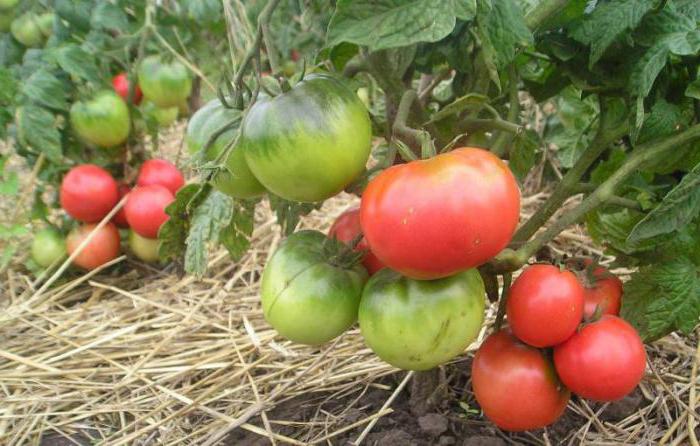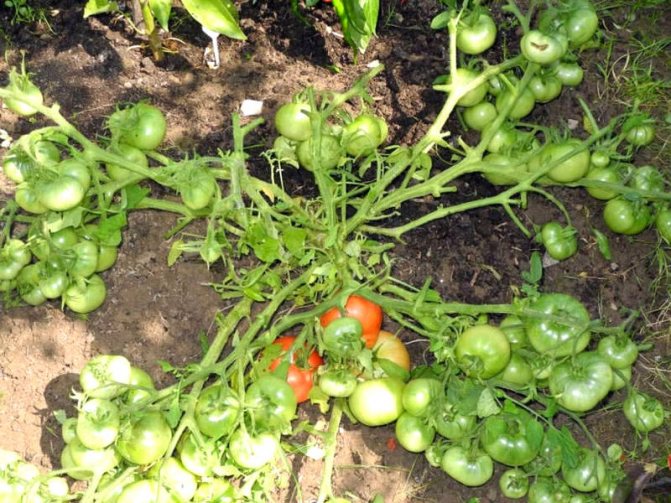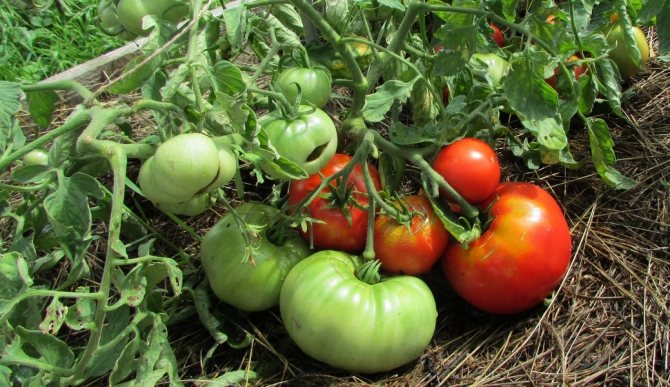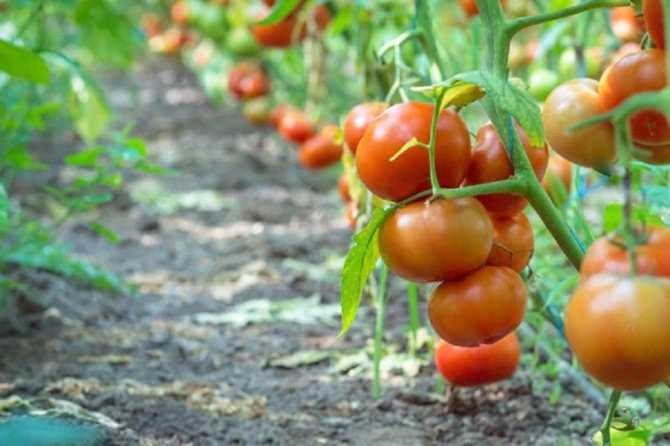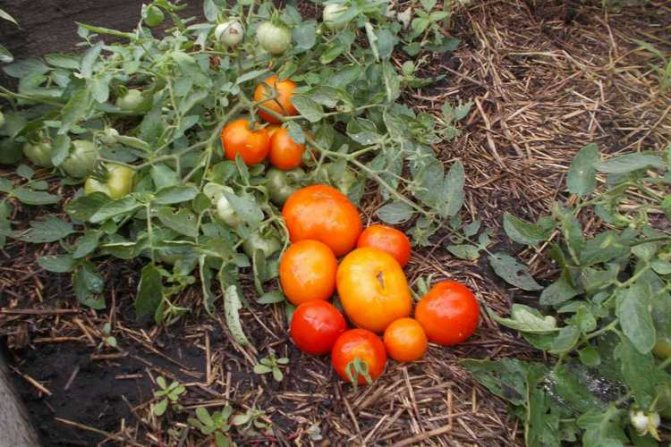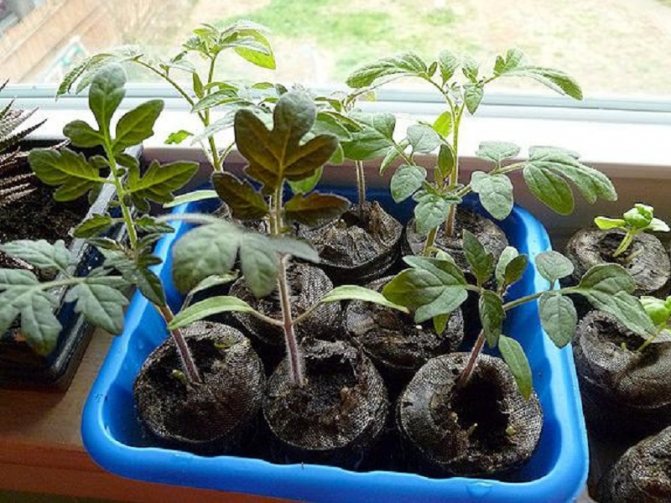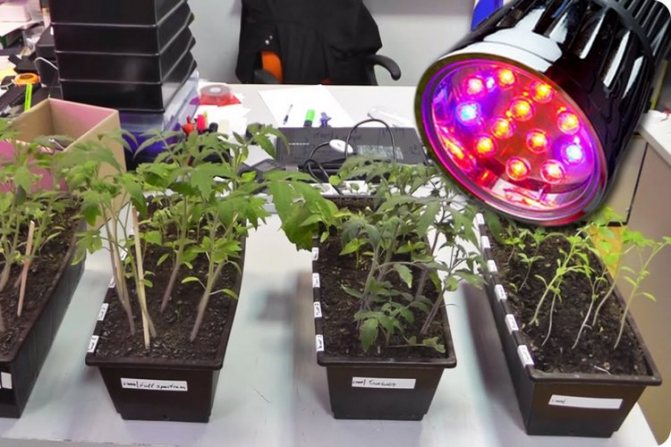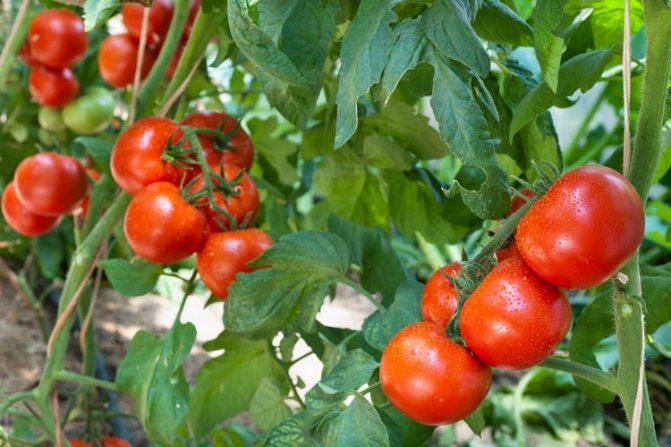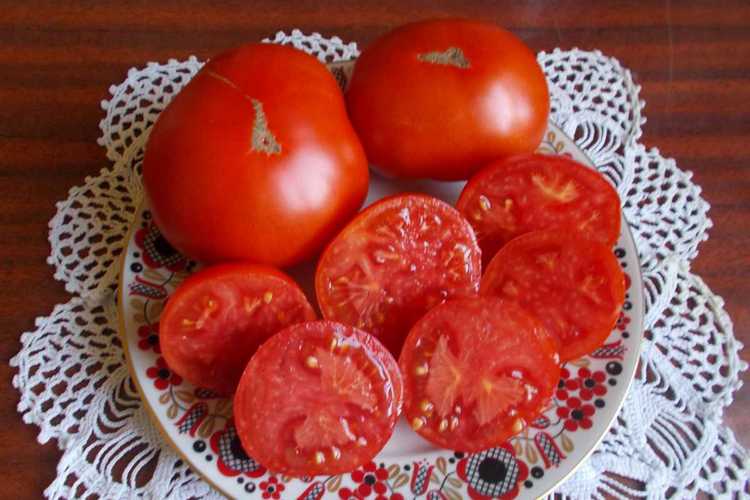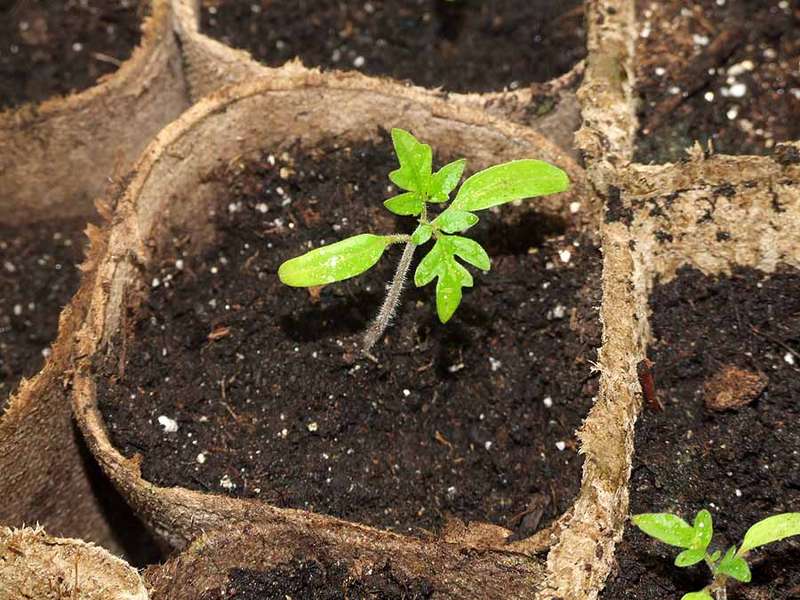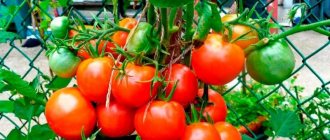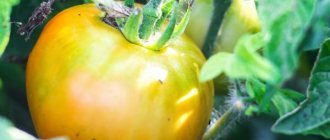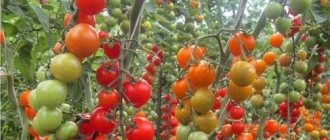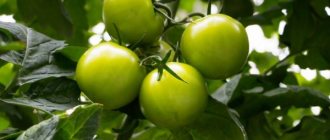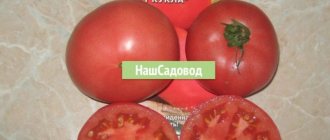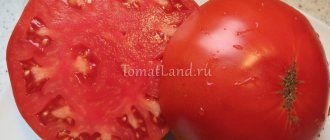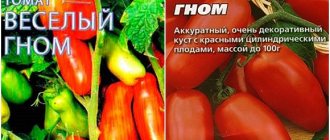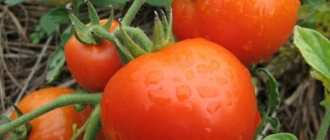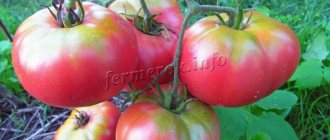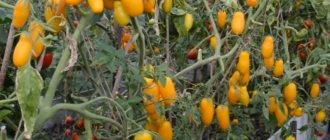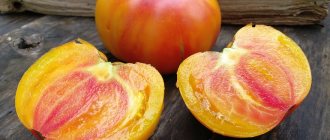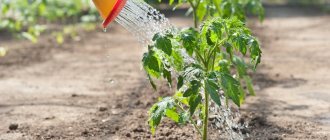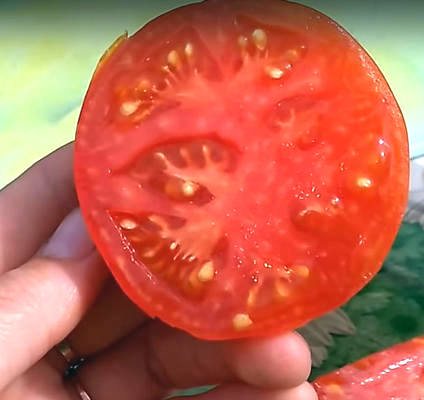
The Mongolian dwarf tomato is a unique and unusual variety. This is an amateur selection, little is known about its origin and the exact date of the appearance of the variety is not known. But for several years the controversy around him has not subsided. Uniqueness of the variety Mongolian dwarf in its characteristics: it is super early, unpretentious, and at the same time, fruitful and tasty. A feature of the variety is that the trunk of the bush at a height of 20 cm begins to bend sharply downward. Stepsons, too, strive for the ground, it turns out a low creeping bush.
| Buy 10 seeds - 40 rubles | Information about practical cultivation experience tomato varieties Mongolian dwarf in the conditions of the Nizhny Novgorod region provided by the owners of the nursery and shop "Fazenda" from Dzerzhinsk... Features and recommendations are made based on my experience. Orders and consultations through the group in "Odnoklassniki", please! |
Unfortunately, possessing such positive qualities, the Mongolian dwarf tomato is still not very common among summer residents. This is probably due to the lack of seeds in garden stores, they can only be ordered from private collectors.
Therefore, when the opportunity arose, we purchased the seeds of this legendary variety for our team. The first cultivation experience did not please us. At the end of the season, most of the plants fell ill with late blight, and the taste of ripe tomatoes was not impressed. But when harvesting the bushes, it became obvious that the potential yield of the variety is high, a large number of ovaries have formed on the plants. This is a feature of the variety - the fruits are located under the leaves and are not very noticeable. Therefore, it was decided to give the variety another chance. The second season of growing tomatoes of the Mongolian dwarf turned out to be successful, we all really liked the variety. For two years of cultivation, it is already possible to draw conclusions about the characteristics of the variety, so we decided to give our feedback on the characteristics and yield of the Mongolian dwarf tomato.
The main advantages of the variety
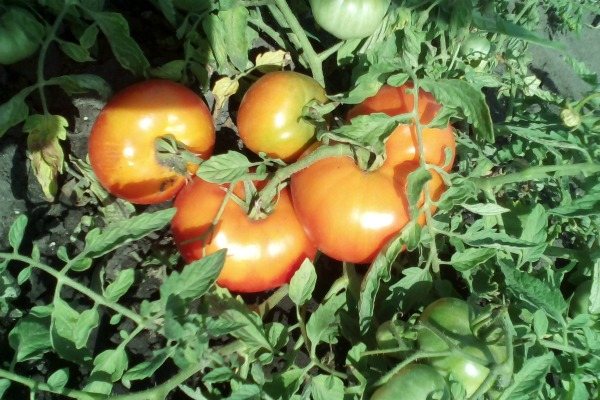

- Ripens in a short time and bears fruit even outdoors;
- There is no need to pinch and tie a tomato;
- Will survive drought and light frosts, while giving a high yield;
- Will suffer a lack of watering, but it is better not to do this;
- some types of disease, such as late blight, are not terrible;
- you can harvest the fruits until the beginning of November;
- tolerates windy weather well.
Many gardeners choose this variety for planting in Siberia and southeast Russia. In these places, the summer is very short, but despite this, the tomato gives a high yield and the fruits are harvested from the bush several times.
Also at the end of summer, there is a large drop of dew, because of this factor, tomatoes can get sick with late blight. The Mongolian dwarf, due to its variety, does not have time to catch this infection.
But in heavy soils and in soil with excess moisture, typical in the Non-Black Earth Region, a tomato of this variety is unlikely to take root and will delight with a rich harvest.
In the south of the country, you can grow this variety of tomatoes in a seedless way, simply by sowing seeds in the garden.
Main disadvantages
For all its positive qualities, the Mongolian dwarf has several disadvantages:
- Seeds are difficult to obtain. Due to the high demand for the variety, the seeds are quickly disassembled in specialized stores.And the quantity in warehouses does not always exceed the demand for this type of variety. Seeds can be purchased from private sellers, but then you do not get any guarantee that you are purchasing the seeds of the Mongolian dwarf.
- You can only recognize the seeds of the variety you bought when the bush is formed.
- The price for this variety may be overstated due to high demand.
disadvantages
- The variety is amateurish and one of the main disadvantages is the purchase of seeds. Large firms do not produce Mongolian dwarf seeds. We have to order planting material from private individuals, which increases the risk of collision with unscrupulous sellers. There is a high probability of purchasing seeds of a different variety.
- Poorly tolerates oxidized soils.
- Fruiting depends on the cultivation method and does not tolerate high humidity. High dampness can slow down the growth of the plant and will have a bad effect on the formation of ovaries, and as a result, on the yield.
- Some gardeners call him "slow-witted", because at the initial stage of growth, he sits for a long time, and then begins to intensively form stepsons and ovaries.
- Dislikes heavy soils.
Like any variety, the "Mongolian dwarf" has its pluses and minuses. Whether it suits you specifically and your conditions, you can only find out by planting it in your garden and experimenting.
Growing features
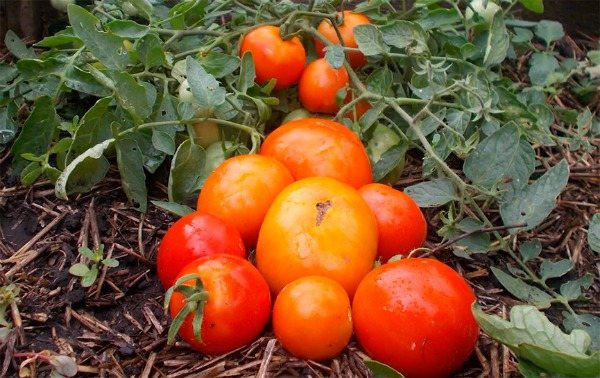

- Due to the low growth of the bush, the fruits lie on the ground. To keep them from slugs and other pests, it is important to properly prepare the soil. You can use a special covering material in black or you can use plywood, boards, straw or other material to fence the fruit.
- In order to get a rich and early harvest, it is necessary to transfer the seedlings to the soil as early as possible. It is enough just to stick the bush into the soil and cover it with some kind of oilcloth.
- Pay attention to the acidity of the soil, too acidic is destructive for this variety.
Planting a Mongolian dwarf in a greenhouse is not always suitable. This variety is afraid of excess moisture, and a poorly ventilated greenhouse can only harm the seedling bushes.
- Many gardeners prefer to plant this variety directly in bare ground. They claim that this way the yield is twice as large as when planted in a greenhouse.
- Try to recede a large gap when planting seedlings. Do not forget that the Mongolian dwarf already grows about a meter around it.
- Plant seedlings at the rate of one bush per half a square meter. If you plant it too close, then cut off the side shoots. Which can subsequently lead to a decrease in yield.
You can start sowing seeds from mid-February. And it is customary to plant seedlings in mid-May. With such a disembarkation calendar, you can taste the first fruits in early June.
But you can get the first tomatoes even earlier. To do this, transplant the seedlings at the end of February into a large container, so you can taste the fruits at the end of May. There is no special manipulation with the cultivation of seedlings, it is grown according to accepted standards.
More interesting varieties:
- Abakan pink
- Banana feet
Caring for tomatoes of this variety
The culture is not whimsical enough, but at the same time you need to follow simple recommendations when caring for the "Mongolian dwarf"
Watering
When planting, the plant needs to be watered as the soil dries. Stable watering will promote faster growth. However, the variety does not tolerate high humidity, if the plant is flooded, or there are prolonged rains, the harvest may not please.
Top dressing
Top dressing is carried out as standard. The variety is susceptible to fertilizers. A solution of wood ash will work most favorably. The ratio of the solution is as follows: add 200 grams of ash to 10 liters of water.
Growing in a greenhouse
Various reviews can be found on growing in a greenhouse.Some get a tomato harvest of up to 300 grams per fruit, while others have a plant showing worse results. But everyone unequivocally claims that the high humidity in the greenhouse is poorly tolerated by the variety.
Steying
As noted earlier, the variety does not need to be pinched, plucked or pinned. A similar number of children is a varietal feature of the plant. Also, a tomato has a fragile trunk, it does not need a garter.
If you are confused that the fruits will lie on the ground, then it is best to mulch the soil. Gardeners claim that the plant grows in such a way that it does not even need mulching.
Attention! After planting, the initial growth rate of the plant is lower than that of other varieties.
Reviews of gardeners who planted the Mongolian dwarf
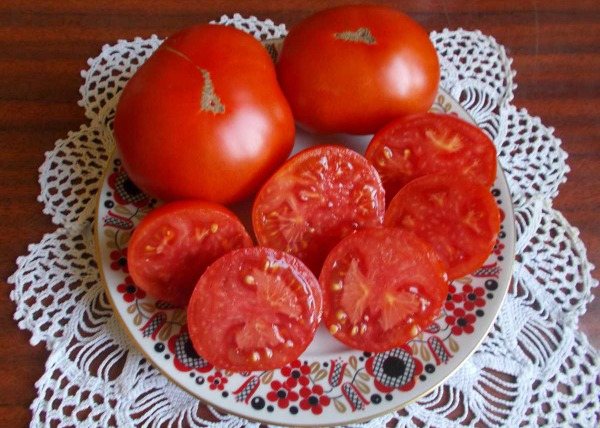

Elena Borisova, 42 years old, Bryansk
“I have experience in planting this variety both in open ground and in a greenhouse. I notice that the yield in the open field is much higher. Now I will only plant in an open area. "
Petr Fedorovich Umarov, 58 years old, Kirov
“The variety is excellent in taste and unpretentiousness. The first time I planted it with apprehension, I was afraid that I could not cope, but all fears were in vain. Got a VERY early harvest. In June, he treated his neighbors with fresh tomatoes from his garden. This year I bought new seeds and recommend the Mongolian dwarf to all gardeners as the most unpretentious and delicious tomato. "
Maria Nikolaevna
“I was very afraid when purchasing seeds from dealers. That I’ll throw my money down the drain. But she was pleasantly surprised by the quick shoots and ovaries. The Mongolian kalik grows on its own, no effort is needed on my part: I planted, watered, fed, harvested before anyone else. "
Dimitrov Oleg
“The first acquaintance did not work out. I planted it in a greenhouse and almost the entire crop died. The fruits were still green, they did not ripen on the windowsill, they tasted sour. Then I podglil about proper care for this variety and now I plant it this year for the third time. In fairness, it should be noted that the taste depends on the weather, tomatoes can sour if over-watered. A whole bucket of large tomatoes can be harvested from one bush. We eat the first tomatoes at the beginning of July. It grows in open ground, I water it with ice water from a hose. "
Nick: Ta Sho Nyusha
“The seeds were recommended by a neighbor. I have never heard of such a variety before. Looked at the forums. The people actively cultivate it and enjoy early fruits. For me, there is nothing special in it, an ordinary tomato, not so sweet as many write. Advantages - no need to dance with tambourines around him when leaving. But I expected more. "
Features of the
Any variety has certain characteristics, which can be conventionally called advantages and disadvantages. This is not entirely correct - after all, some features can be an advantage, for example, for private cultivation and a disadvantage for an industrial one, and vice versa.
- The Mongolian dwarf matures very early, even outdoors and in cold regions;
- There is no need to constantly pinch and tie up the bushes;
- Productivity is maintained during dry periods;
- Does not need regular and thorough watering;
- Absolutely not sick with late blight, never;
- Brings harvest until late autumn, right up to the onset of cold weather;
- Resistant to bad weather conditions, especially cold;
- Due to its short stature, it is practically invulnerable to wind;
- Seeds are difficult to find as the variety is not officially listed;
- The variety is categorically not suitable for growing in warm regions, where the fruits will deteriorate before they have ripened, and the bushes will wither.
Description of the variety, characteristics with photo
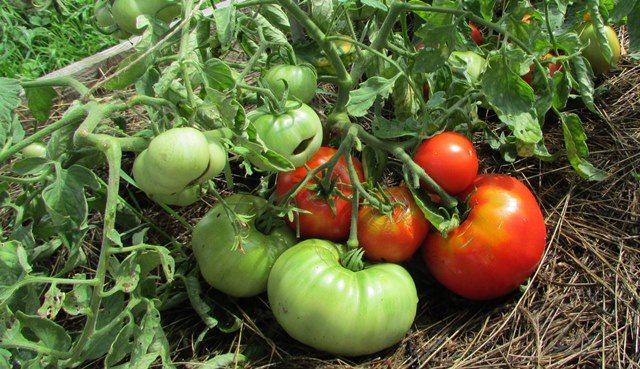

This variety of tomatoes was bred for the zone of risky farming. It is recommended for planting in open ground in Siberia, the Urals and the Far East. Tomato "Mongolian dwarf" refers to superdeterminate varieties. Its bushes do not exceed 15-20 cm in height.
Many stepchildren grow on the main lodging stem, which should not be picked off. After all, it is on them that ovaries and fruits are formed. These tomatoes do not require garters, shoots spread along the ground, forming a massive bush up to 1 m wide. The leaves are narrow, strongly pubescent.
From the characteristics, it can be noted that this is a super early variety - fruiting occurs at the end of June. Due to the rapid ripening, the fruits are not damaged by late blight, since the main harvest can be obtained before the onset of the rainy season. Fruits are round, bright red, large. The average weight of one tomato is about 200 g. Fruiting continues until the frost. From each bush, you can collect up to 10 kg of ripe tomatoes with a sweet taste.
On a note! These tomatoes are not subject to rotting and cracking.
Appearance
Tomato fruits have a classic "tomato" shape and color, so they are difficult to distinguish from many other varieties by the appearance of the harvested tomatoes.
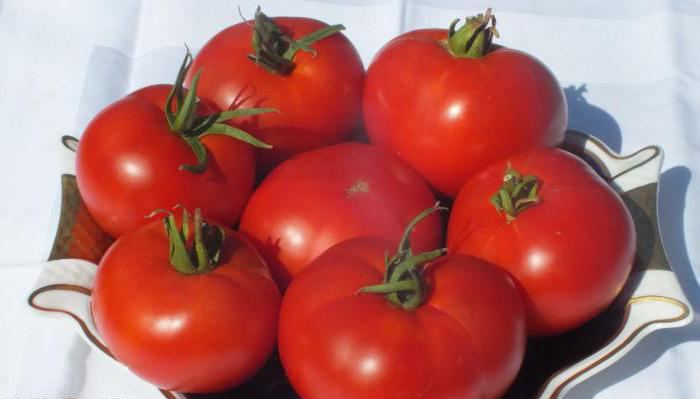

Seeing the harvested fruits of the Mongolian dwarf tomato, one can say: "Nothing special, there are a lot of such tomatoes."
However, what can be seen directly on the bed will practically dispel doubts that it is the Mongolian dwarf in front of you: apparently, only he can creep along the ground and carry a huge number of even bright red rounded fruits.
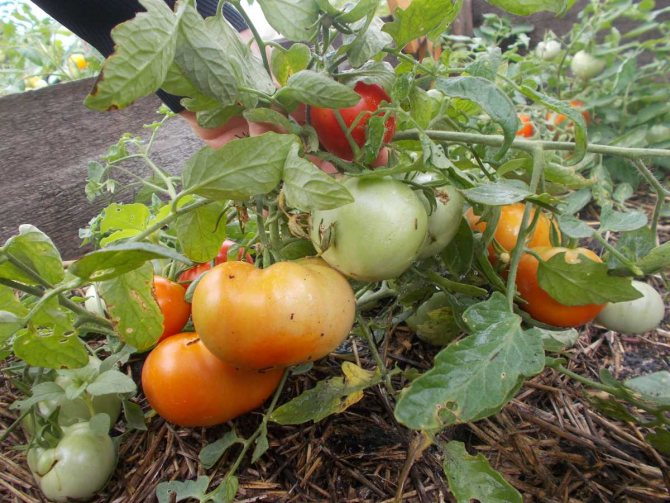

The Mongolian dwarf grows as if "lying", and the tomatoes are located on the ground, on which bedding is often laid
Pros and cons of the variety
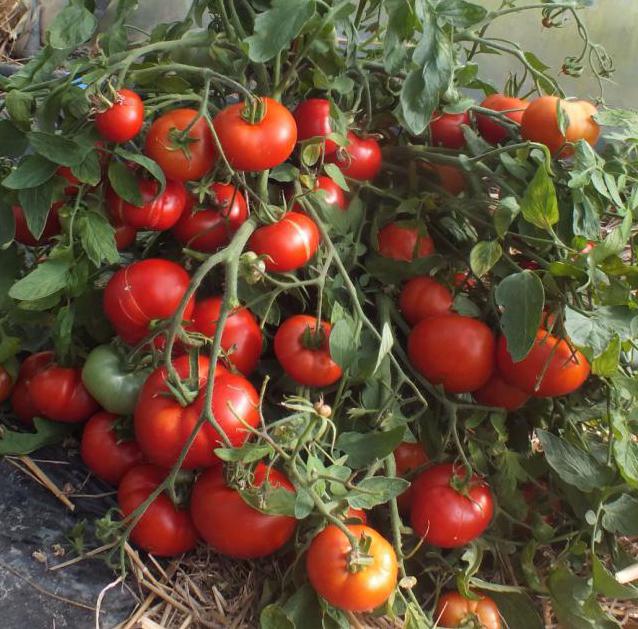

The variety has its own obvious advantages, which attract the attention of summer residents to it. Speaking about the advantages of the "Mongolian dwarf", the following advantages can be highlighted:
- the variety is adapted to the harsh climate of northern latitudes;
- early fruiting, even in open ground;
- does not need pinching and tying;
- tolerates drought well without loss of yield;
- not affected by late blight;
- has a long fruiting period;
- does not respond to a sharp change in weather conditions;
- the tomato is resistant to wind gusts.
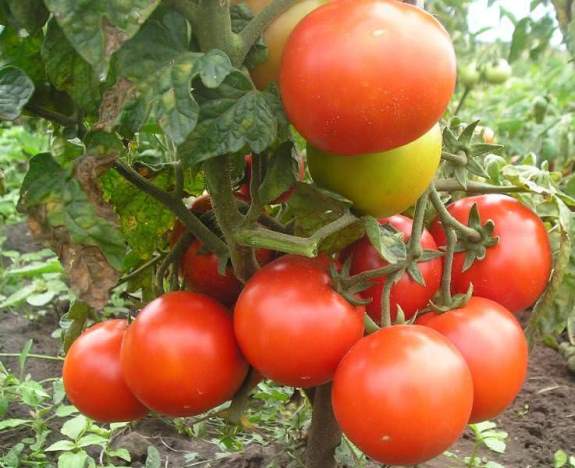

Those who have already had experience in growing this variety note that it is perfectly adapted to the conditions of the northern summer with its temperature drops and abundant dew at the end of the summer season. The massive harvest is usually obtained in mid-August, so unfavorable weather conditions do not have time to harm tomatoes and cause the appearance of diseases.
Not afraid of "Mongolian dwarf" and dry areas with strong winds. Due to the heavy soil and high humidity, the non-black earth regions are not very suitable for the variety. In the southern regions of Russia, tomato can be successfully grown on light soils in a seedless way, sowing seeds directly into open ground.
The downside for growing this variety is the difficulty of acquiring seed. Large firms do not produce it, since the variety is amateur. And when buying from individuals and on the Internet, one cannot be sure that the seeds of the "Mongolian dwarf" are offered for sale. The substitution can be seen only during the growth of the bushes. It is with this that the conflicting reviews on this variety of tomatoes are associated. Most likely, gardeners simply faced a fake.
Origin and regionalization
This variety is especially popular among vegetable growers in Transbaikalia and Siberia, presumably it was bred by breeders from Novosibirsk, but has not yet been included in the State Register of Breeding Achievements of the Russian Federation. For this reason, tomato seeds are difficult to find in the public domain, however, planting material can be purchased on the Internet or in the market from familiar vegetable growers.
The Mongolian dwarf does well and grows well in regions of the north with cold springs and autumn. It takes root well in places with an arid climate and constant winds, provided there is no late blight there.
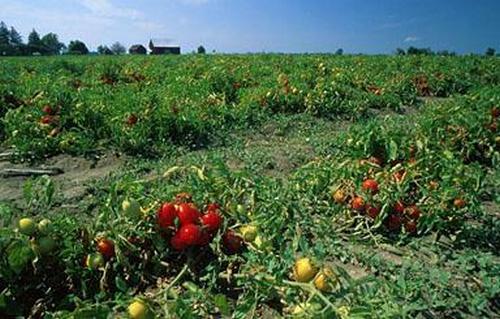

Growing features - planting and care
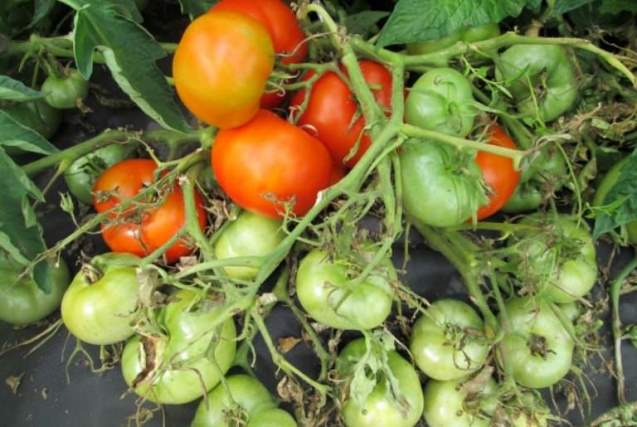

Growing tomatoes begins with sowing seeds for seedlings.The best period for this falls on March 20 - April 5. You can successfully sort the seeds in a solution of table salt. You can discard the planting material, which will float up within 5 minutes - it will not produce high-quality seedlings.
The seeds that have sunk to the bottom are washed and prepared for planting. To get rid of pathogens, soak the sowing material in a weak solution of potassium permanganate for 30 minutes, after soaking, rinse again and dry slightly. Now you can start landing. As a soil, it is permissible to use a purchased substrate, or to compose it yourself from turf and humus.
- The landing box is filled with earth, leveled and moistened.
- Every 4-5 cm, grooves with a depth of 1 cm are cut with a suitable tool.
- Seeds are placed at a distance of 1 cm from each other and sprinkled with soil.
- A film shelter is built on top and the boxes are moved to a warm place with a temperature of about 25 ° C.
- As soon as shoots appear, the film is removed and the boxes with seedlings are rearranged to the brightest place.
- A pick of seedlings is carried out after the appearance of 2-3 true leaves. Each plant is carefully moved into a pot with a diameter of 9-12 cm.
On a note! Seedlings of this variety will not grow large, this is a feature of the "Mongolian dwarf". Lack of growth should not be interpreted as a lack of nutrients.
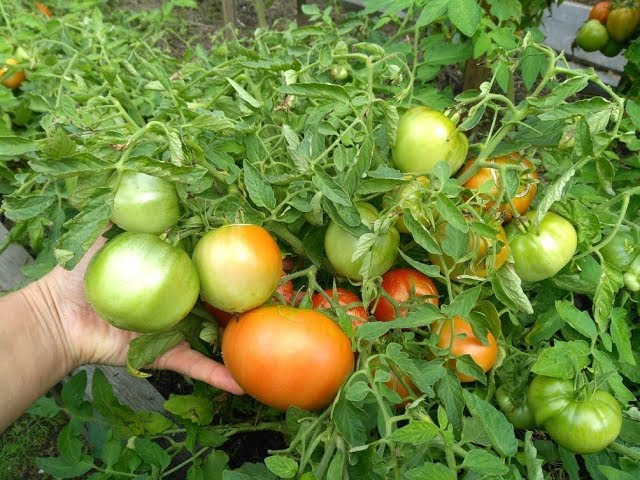

They are engaged in landing in open ground as soon as the threat of frost has passed. This usually happens in late May or early June. You can do this a little earlier if the landings will be under a film cover. For normal growth, these plants need a lot of space, so the holes are made at a distance of 60-80 cm. Due to the stepsons, the bush grows strongly in breadth.
Before planting, 10 g of superphosphate and a small amount of humus are laid out in the holes. The land is watered abundantly and seedlings are planted. This should be done at an angle. After planting, the roots and the lower part of the stem are sprinkled with soil and watered again. Planted plants can not be watered for a week. During this period, their rooting will take place.
In the process of growth, the bushes of the "Mongolian dwarf" are watered as needed, avoiding sudden changes in soil moisture, which can adversely affect the quality of the fruit. After watering, the soil must be loosened so that a hard crust does not form. To increase the amount of the crop, do not forget to apply top dressing. The first time the plants are fertilized 2-3 weeks after planting in the ground. The next two dressings will need to be done during the ripening period of the fruit.
Helpful advice! Experts recommend using infusion of freshly cut grass and wood ash as fertilizer for these tomatoes.
Reviews of gardeners who planted
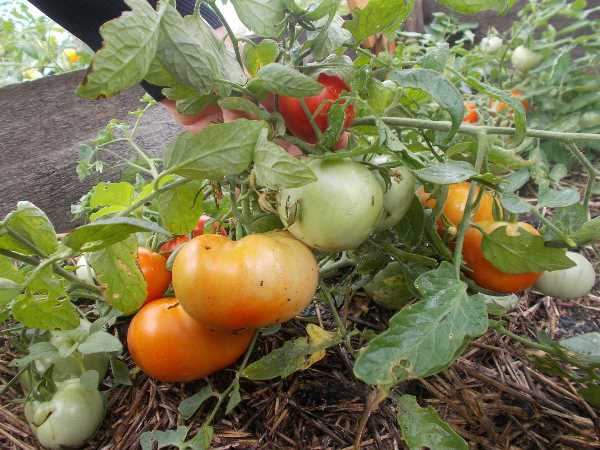

In connection with the frequent substitution of "Mongolian dwarf" when buying, pay attention to the packaging. If in the photo you see a tied or just a tall bush, it means that you are being offered tomato seeds of a different variety. We repeat that the "Mongolian dwarf" grows to a height of no more than 15-20 cm and forms a bush in breadth. This is what those who managed to acquire real varietal seeds and grow this tomato on their site write about him.
Margarita, Bryansk
I grew these tomatoes on my site for 3 seasons in a row. I tried to plant both in a greenhouse and in open ground. I can say that the tomatoes in the garden turned out even better, the harvest pleased me - it was plentiful. True, in the greenhouse the fruits were somewhat larger, but there were fewer of them. I decided that now I will grow this variety only in the open field.
Fedor, Kirov.
Great variety! I planted it for the first time and was pleased with the result. The tomatoes did not require much care in leaving, and they gave a lot of fruits. And what is especially important is the early ripening variety. I ate my tomatoes in June, all the neighbors were jealous.So I give the "Mongolian Dwarf" the best recommendations!
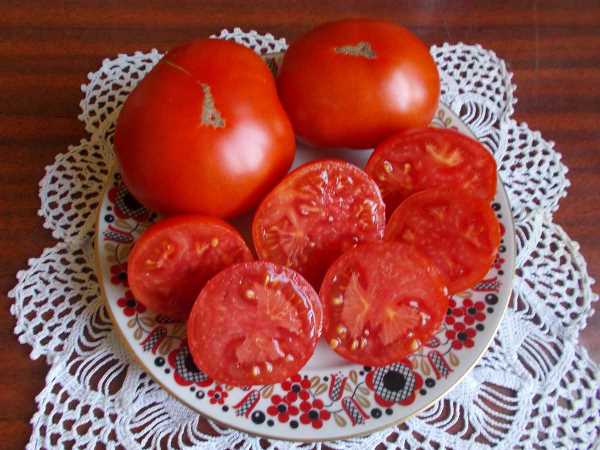

Olga, Komi Republic.
I grew this variety last season in a warm garden bed. No problems in care, did not hurt, the fruits are large enough, the usual tomato flavor. It was quite suitable for our zone of risky farming. This year I will definitely plant again.
Irina, Kaliningrad.
The Mongolian dwarf did not impress me. Perhaps the rainy, cool summer is to blame. Planted in open ground. The bushes developed very slowly, blooming only in early July. The tomatoes turned out to be small in size and sour taste. I think that it is better to plant it for seedlings in February, otherwise it will not have time to give a full harvest in the open field. Most likely, this variety is more suitable for greenhouses.
Mohammed, Naberezhnye chelny.
A good, productive variety. 5 buckets of tomatoes were collected from 10 bushes. Later the tomatoes were still ripe. Requires almost no maintenance. Only watered and fertilized several times. Grown in open ground, the bushes began to bear fruit early. I will plant it myself and recommend it to others.
Description and characteristics of a low-growing tomato
Before choosing this variety for planting in your summer cottage, you need to understand its characteristics and features. We will talk about this further.
Appearance
At the moment, this is the shortest tomato. The height of the bush does not exceed 30 cm, which does not negatively affect the size of the fruit.
The bush creeps along the ground, forming new stepchildren. As a result, the width of the bush can reach 1 meter or more. Leaves are narrow with a strong edge. Many small leaves can be seen on the bush.
The stems are thin and fragile. The root system is shallow, but sufficient to support the bush during strong winds. The fruits are collected in a brush.
The main qualities of the fruit
Despite the fact that the bushes are not tall, the fruits of the Mongolian dwarf weigh up to 200 grams, which is a good indicator. The variety is early ripe, so the fruits are not affected by late blight with proper care.
The bright red fruits are dense, but juicy inside. The taste is not much different from ordinary tomatoes. We can say that the taste is standard "tomato". Up to 10 kg of quality tomatoes can be harvested from a bush.
Advantages and disadvantages
As practice shows, the Mongolian dwarf grows well in the eastern and southeastern regions of Russia, where the summer is short. However, before deciding to plant in a specific area, it is best to familiarize yourself with the pros and cons of this variety. Let's start with the pros:
- high productivity of the bush;
- there is no need to tie and pinch;
- no need to create special conditions for growing, it can grow in a greenhouse in an open-air garden - a universal variety, resistant to temperature extremes;
- does not like excess moisture;
- bears fruit until late autumn;
- due to its early maturity, the dwarf is weakly susceptible to phytophthora;
- low bushes withstand strong winds well and do not break.
Any variety has disadvantages. Although the Mongolian dwarf has a few of them, they still have:
- grows poorly in acidic and heavy soils, as well as in areas with a humid and hot climate;
- the initial growth phase is very long. At first, the plant does not show types of growth, and then it begins to grow rapidly in breadth;
- this variety is not yet in state registers, so it will not be possible to buy it in the nearest shop with seeds.
Features, differences from other varieties
Distinguishing the Mongolian dwarf from other tomatoes is not difficult. The height of the bush cannot exceed 50 cm. The main trunk, reaching a height of 20 cm, begins to bend sharply downward, which is a specific feature of the variety. From the main trunk, stepchildren grow, which also creep along the ground.
This variety can tolerate a prolonged lack of watering, but this should not be overused. Before planting, the soil is mulched. In addition, as noted earlier, harvesting can be carried out until late autumn, when the first frosts come.
The fruits are weakly susceptible to spoilage, even lying on the ground covered with leaves, they retain their properties for a long time, do not crack and do not rot.
Advantages and disadvantages, features, differences from other varieties
The very description of the Mongolian dwarf variety indicates that interest in it should be high. Indeed, this tomato has a fairly large number of advantages. This is, for example:
- a high degree of adaptation to harsh climatic conditions;
- drought resistance;
- ease of care: no need to form and tie bushes;
- very early ripening of the crop;
- the duration of fruiting;
- high resistance to late blight;
- the possibility of growing in a seedless way in warm regions;
- transportability and good keeping quality of fruits;
- large-fruited, uncommon for superdeterminate varieties;
- high productivity.
The variety also has disadvantages. Gardeners especially often complain about the following:
- the difficulty of acquiring real seeds of this variety;
- a sharp decrease in yield in conditions of high humidity;
- negative attitude of the plant to heavy soils;
- not very high taste of the fruit.
Since the Mongolian dwarf is intended for open ground in cold regions, where there have always been big problems with growing tomatoes, it should be recognized that the ratio of the pros and cons of the variety still speaks of its high prospects: with such a high yield and unpretentiousness, the noted shortcomings go into the background. It is difficult to even remember another widespread variety with similar properties.
Among the early varieties, for example, White filling with fruits of a similar shape, but smaller in size, has long been considered revered. However, it is not entirely appropriate to compare these tomatoes: they differ greatly both in the shape of the bush and in consumer qualities.
Recently, many varieties and hybrids of tomatoes have appeared, which are also early and superdeterminate. These are, for example, Alpha, Gina, Aphrodite, Sanka, etc. These are varieties that bear fruit with tomatoes similar in shape and color to the Mongolian dwarf, rather high-yielding and ripening early. However, most of similar varieties grow to at least half a meter in height, and only a dwarf spreads along the ground. Whether this is considered an advantage is a moot point, but the fact that the Mongolian dwarf is of great interest is beyond doubt.
Features of growing and planting an early species
The dwarf was originally intended for cultivation in the eastern regions of Russia, but as practice has shown, due to its unpretentiousness, the Mongolian dwarf is successfully cultivated in other regions. It is not recommended to plant this variety in areas with high humidity. The cultivation technology is not much different from the cultivation technology of other varieties.
Seedling and seedless growing method
The Mongolian dwarf variety is grown by seedlings and seeds. The seedless method is used in the southern regions of the country. 5-6 seeds are placed in the hole. After the appearance of 2-3 leaves, they break through the ground. After that, only strong plants are left.
In places with more severe conditions, seedlings are sown. Seeds are germinated in a pot or greenhouse at home. The seeds are sown so early that in May they plant a bush in the garden at the beginning of flowering, and by the end of June, get the first harvest.
Use slightly acidic sandy soil. Such land is sold in shops for gardeners. The land is suitable for nightshades or any vegetable crops. You can also fertilize such soil yourself.
To harvest a good harvest, a number of recommendations should be followed:
- from the fall, the beds for planting tomatoes must be carefully plowed;
- per 1 square meter in early spring: 50 g of superphosphate, 20 g of ammonium sulfate, 25 g of potassium salt;
- pre-process the seeds;
- plant seedlings and grow them according to the recommendations;
- properly care for tomato bushes.
Seed preparation and planting
The seeds must be processed before sowing. First you need to pay attention to the expiration date of the seeds. The Mongolian dwarf has a shelf life of 2 years.
Calibrate the seeds and treat with a disinfectant solution. A mixture of aloe juice and 1% potassium permanganate is suitable as such a solution. Further, preliminary soaking and germination are carried out.
Planting rules and care for seedlings
The process of sowing seeds for seedlings consists of several stages:
- earth is poured into the container, which is previously disinfected;
- make grooves or holes about 1 cm deep. If the seeds were germinated in advance, then the holes and grooves need to be watered;
- sow seeds in previously created depressions with a distance of 1-2 cm;
- sprinkle with earth and watered;
- a container with earth and seeds is covered with polyethylene and placed in a warm place (25-30 degrees) until shoots appear. Usually the first shoots appear in 5-6 days.
Perhaps our other article will be useful to you - "How to grow tomato seedlings: useful recommendations."
You need to water it with warm, previously settled water as the earth dries up. When 2-3 leaves appear, the plant is transplanted into separate pots. Seedlings are planted in the beds, the age of which is from 45 to 60 days. Usually such seedlings already have 7-8 leaves.
Rules for planting seedlings in open ground
Planting is carried out in a well-lit sun, protected from the winds. A week before planting seedlings, the beds prepared from the fall are treated with magnesium sulfate and fertilizers are added. It is recommended to adhere to the following rules:
- plant seedlings in 2 rows, leaving a distance of 50-60 cm between plants and rows;
- seedlings are planted 2-3 cm deeper than they grew in containers;
- before planting and after, pour the ground with water at room temperature;
- water the seedlings 3 days after planting;
- plant more in the place of the dead sprouts;
- it is necessary to mulch the holes with straw;
- this variety does not require tying, but pegs can be installed.
Greenhouse landing
The Mongolian dwarf is usually grown outdoors. Those who want to grow it in a greenhouse can do this, but it is important to remember that the yield directly depends on high-quality ventilation. This is due to the fact that this variety does not like increased moisture and the crop may simply die from its overabundance.
The greenhouse will need to be opened on warm days, because the excess heat also negatively affects the yield of the dwarf. This must be taken into account if other varieties grow in the greenhouse, which, on the contrary, need a lot of heat and moisture.
It makes no sense to occupy the entire greenhouse only with a Mongolian dwarf. In addition, the beds in the greenhouse should be wide enough, since the bushes of this variety spread along the ground. Otherwise, growing a Mongolian dwarf in a greenhouse is no different from growing other varieties of tomatoes. You just need to adhere to the recommendations mentioned above.
Experienced advice
It is not at all difficult to care for the seedlings of the Mongolian dwarf, but it is recommended to adhere to certain recommendations:
- 10 days after planting, it is necessary to water with a 2% solution of potassium permanganate to prevent late blight infection;
- the beds should be made slightly higher than for other varieties of tomatoes, since the Mongolian dwarf creep along the ground, otherwise higher beds will reduce the contamination of stems and leaves with soil;
- you need to water the plant sparingly, because the dwarf does not like abundant moisture;
- Experienced vegetable growers recommend placing black film or planks under the tomatoes to reduce the likelihood of spoilage of the fruit by soil pests.
Top dressing and their amount
You should confine yourself to top dressing at the roots, because it is advisable not to wet the tomato leaves again.Before feeding, the bushes are watered. Top dressing is done according to the following schedule:
- the first is carried out 2 weeks after planting in the garden;
- the next time the plant is fed before the appearance of fruits;
- the third is carried out 2 weeks later.
Fertilizers are diluted with 10 liters of water:
- ammonium nitrate 20 g;
- phosphorus-containing fertilizers 80 g;
- potash fertilizers 50 g.
The following supplements can be used to increase the yield:
- Dissolve 0.5 manure in a bucket of water.
- 0.5 liters of manure infusion, 2 tablespoons of phosphorus-containing fertilizers, 1 tablespoon of potash fertilizers are diluted in 10 liters of water. Phosphorus-containing fertilizers are soaked in advance, since it does not dissolve well.
- 0.5 liters of manure, 1 tablespoon of potassium sulfate, 7 grams of boric acid, add to 10 liters of water. 1.5 liters of the finished solution is applied under each plant.
- Ash solution is also very popular. 200 g of ash per 10 liters. Infused for 2 days. Such feeding will contain a lot of trace elements.
- Store-bought supplements can be used.
- Recently, "green dressing" has become popular. For 200 liters of water, take 1 kg of ash, 0.5 kg of manure, 2 liters of whey, 100 g of yeast and fresh grass. The liquid should completely cover the greens. The contents are mixed daily for 2 weeks. When the fertilizer is ready, the grass is placed under each plant when mulching, and the liquid is used for watering - 0.5 liters for each bush. Sugar can be used in place of yeast. Take 150 g of sugar per 3 liters of water and incubate for 3 days. This mash is added instead of baker's yeast.
Cow or chicken manure is used. It is better to feed before sunrise or after sunset, otherwise fertilizers may dry out. If tomatoes grow in a greenhouse, then the bushes are fed before sunrise and after feeding the greenhouse should be aired.
Testimonials
★★★★★ Valentina Vasilievna, 65 years old, pensioner, Moscow region Last year, I planted a Mongolian dwarf in a greenhouse for a sample. The place he got was not the best, at the northern wall in the shadow. She did not take particular care of him. I was very surprised when I gathered a decent harvest from his bushes. The fruits weighed 120-150 grams. At first they were sour, but after lying down a little they became sweeter. A very tenacious variety. Recommend. ★★★★★ Angelina Mikhailovna, 58 years old, summer resident, Chelyabinsk. I really liked the dwarf. Last year I planted it for the first time and decided that next year I will plant it again. His bush is small, it can be planted among other high varieties. The tomatoes grew delicious and beautiful in color. ★★★★★ Alexey, 37 years old, dentist, Belozerka. This variety is very tenacious. It always grows well for me, because I use my planting material collected in the fall. I fertilize with nitrogen and never stepchild. The yields are decent. Submit your review
The Mongolian dwarf is an ideal choice for beginner gardeners, as it is very easy to grow. This variety is unpretentious, the harvest can be harvested from May to October, while the taste of its fruits is not inferior to other varieties. However, experienced gardeners will also like it. This variety is well suited for growing in areas that are not suitable for other varieties.
The Mongolian dwarf is a low-growing variety of amateur selection, it is not included in the State Register. Due to a number of varietal characteristics, it is suitable for growing in regions with short and cold summers. According to the description of the variety, photos and reviews, the Mongolian dwarf tomato forms standard, super-low-growing bushes about 30 cm high.
Plant characteristic
As the name implies, the plant is dwarf. Outwardly, this manifests itself, first of all, in its short stature - in height the bush very rarely rises above 20 centimeters, usually stopping at 15. After the plant has reached this "mark", its growth goes to the sides.
The spreading bush begins to literally creep along the ground, it gives very long shoots. As a result, one adult bush occupies an area of about half a square meter. Shoots are densely covered with leaves, they are large and spreading, bright and rich green.
All shoots, each sinus, forms a brush, where fruits are then formed. Due to this, the variety becomes very productive, a whole bucket of tomatoes is often collected from one plant.
The fruits of the Mongolian dwarf are not dwarf at all, no matter how funny it sounds. The average weight of one tomato is about 150 grams, but tomatoes are often found and 200 grams each.
The fruit has an interesting feature. Depending on how the weather prevailed during their ripening, they can change their taste quite dramatically. If the summer was cool, the sun did not shine so much, then the sourness will be clearly audible in the taste. If the summer, on the contrary, was hot and warm, then you will definitely feel the sweetness.
Read also: Review of the best varieties of self-pollinated cucumbers, which cucumbers are better self-pollinated or bee-pollinated
Growing seedlings
It is advisable to grow tomatoes of this variety through seedlings. Sowing early gives a significant advantage in short, cold summers.
Attention! To accelerate germination, seeds can be warmed up for 2-3 days at a temperature of 38-40 ° C before sowing.
For growing seedlings, it is necessary to prepare plastic containers with a depth of 20-25 cm and a light, nutritious substrate. The soil can be made up of equal parts:
- humus,
- sand,
- turf land.
It is necessary to sow seeds to a depth of no more than 0.5 cm.
Tomatoes of this variety are planted on seedlings no earlier than the second half of March. Sowing earlier is possible with a heated greenhouse.
After the appearance of the first shoots, the box with crops is transferred to a well-lit place with a temperature of 22-25 ° C. A higher temperature is not desirable, as the seedlings begin to stretch strongly.
As needed, seedlings are watered with warm water. Watering is carried out at the root. Water contact with leaves can lead to the development of fungal diseases. Once every 10 days, the seedlings are fed with a complex mineral fertilizer. After the appearance of the second true leaf, the tomatoes are dived into separate cups. By the time they are planted in the ground, they should form 4-5 sheets.
Advice! According to the characteristics of the variety, the Mongolian dwarf tomato can also be sown directly into a greenhouse with a litter based on manure. In the process of natural "burning", manure releases a lot of heat.
Mongolian dwarf tomato where to buy seeds
You can buy seeds of the legendary tomato variety Mongolian dwarf in the community in classmates, group "Fazenda, Dzerzhinsk" The price of 10 seeds is 40 rubles, the seeds are packed in zip packages.
| Buy 10 seeds - 40 rubles
| Store "Fazenda, Dzerzhinsk" Nizhny Novgorod region |
| A group in OK for keen gardeners! We are happy to advise on the gardening topic, inform about promotions, news in our retail store. Sale of seeds, seedlings, goods for gardeners. We accept orders from other regions with delivery by mail. Join !!! |
Care
The tomato variety needs timely care.
- Shelter. Immediately after planting, it is recommended to cover unstable plants with a layer of non-woven covering material. It will protect against sunburn, frost. In regions with an unstable climate, the shelter can be left for the entire growing period.
- The peculiarity of growing the Mongolian dwarf is the absence of a garter. Creeping bushes of this variety do not need supports. After creeping, straw is placed under the bushes. It prevents the development of weeds, protects the fruits from contact with the ground.
- Subsequent care for tomatoes consists in timely watering and fertilization.
- For top dressing, it is more convenient to use universal mineral complexes that provide plants with the necessary nutrients.
- In a short summer, the growth of bushes must be limited. This will allow existing fruits to ripen. For this, the last flower brushes and the crown are removed on the bushes. The yield will decrease slightly, but the rest of the fruits have time to fully develop and ripen.
Attention! When planting seedlings, it is necessary to take into account that the distance between the bushes should be at least 70 cm. A denser planting significantly worsens illumination and airing.
Gardeners advise to cut off all the leaves in August, leaving bare shoots. This facilitates the ripening of fruits in the garden in a short summer.
How to store and use crops
Harvesting is necessary when the tomatoes are almost ripe, but still not quite. Since the bush is undersized, the fruits often literally lie on the ground. After they have been collected, I strongly recommend wiping the tomatoes with a cloth - various diseases and pests can be transmitted from the ground, and excess moisture will cause the fruits to quickly rot.
After that, dry the tomatoes in the sun for several hours and remove them. It is better to collect in plastic containers with a lot of holes, in cardboard boxes or bags, but always from natural materials.
The fact is that tomatoes, like any other fruits, cannot be packed and stored in polyethylene for a long time. It does not allow air to circulate and the plant simply deteriorates.
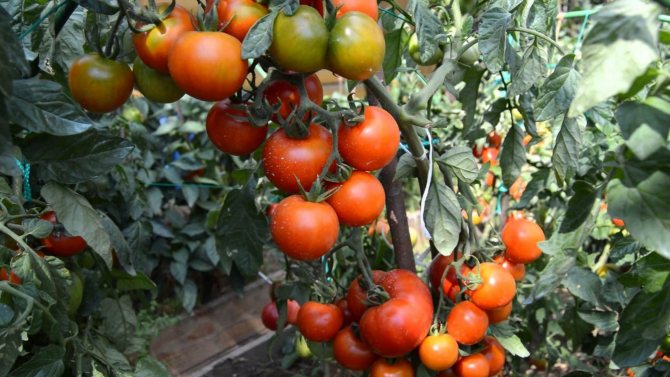

Pest control
During cultivation, the tomato can suffer from insect attacks. The most common pests are described below.
Slugs
In most cases, the Mongolian dwarf is grown in a spread, so its fruits are located directly on the soil, attracting slugs. For pest control, you can use folk methods and chemicals.
Slugs are close relatives of snails. On the surface of the earth, they move with the help of a kind of leg. A well-visible path of mucus is left behind. With a tongue resembling the smallest grater, they scrape off the pulp of tomatoes. In one season, in the absence of treatments, 3-4 generations of slugs can be hatched.
If the number of pests is small, mechanical control measures can be used. For this, pieces of boards or cardboard are laid out in the aisles. After a night out, slugs use them as hiding places. Discovered pests are simply collected and destroyed.
Of the traditional methods against slugs, a mixture of pepper, ash and salt is most effective. All components are mixed in equal proportions. The finished mixture is simply scattered over the surface of the beds.
Slugs don't like mechanical barriers. They make a kind of border around the perimeter of the garden. Most effective:
- a layer of crushed shell rock,
- gravel.
- eggshell.
Of the chemicals used to kill slugs, granules are used:
- "Slime Eater"
- "Thunder",
- "Meta".
They use metaldehyde as an active ingredient. Even prolonged rains do not affect the effectiveness of these funds.
Aphid
Aphids are a widespread sucking pest. A characteristic sign of its appearance is twisted, deformed leaves. If the leaves are straightened, clusters of aphids are found on the inner surface. With a small number of pests, treatments with a solution of ordinary laundry soap are effective. In most cases, a single spray is sufficient.
With a large number of aphids, the use of chemicals is indispensable. You can use drugs:
- Aktara,
- Alatar,
- Fufanon.
Dilution rates and rules for their application are indicated in the annotations.
Spider mite
In hot, dry years, a massive spread of spider mites can be observed. To destroy it, it is necessary to use special preparations of acaricides.Due to biological characteristics, the use of insecticides is ineffective. To combat spider mites use:
- Actellik,
- Fitoverm.
Processing is carried out twice with an interval of 10 days.
Send feedback on growing tomatoes in the comments. All reviews after verification are posted on the site.
Planted a variety last year. Liked it, unpretentious !. A dwarf he is a dwarf - height 30 cm. Tomatoes just lay on the ground, littered with straw. I liked the fruits, they are delicious. No pain, early fruiting began. No need to pinch, tie up.
Olga, Moscow region
For several years I have been growing Mongol in a greenhouse on the south side. I sow seeds on February 1, I get the first fruits in late May - early June. Tomatoes have a good taste, tomato, thin skin, fleshy pulp. The bushes are small, I plant them under the large ones, then I remove them when the tall ones, the later ones come into fruiting. I plant a part separately and they bear fruit for a long time, only at the end the tomatoes become smaller. Good yield - almost a bucket from a bush! When they start to ripen, I put the planks under the tomatoes so that they do not lie on the bare ground. At the beginning of August, you need to remove all the leaves, flowers, cut them well, then it will ripen in the garden.
Irina Evgenievna, Tula
Planted a dwarf last year. I liked the unpretentious variety, the yield pleased. Tomatoes weighing 150-300 g, taste is acceptable, tomato. As an early variety, it is good, and it bears fruit for a long time. I will plant this year at the feet of other indeterminate tomatoes.
Tatiana Ivanova, Samara
On the advice of a neighbor, I planted it last year in a greenhouse at the feet of the Indets. They began to ripen in early June, the fruits are average, but the harvest is small! Then the fruits began to shrink. I used to plant it outdoors - the harvest was better. The taste in both cases is sour, the tomatoes are juicy, fragrant. The harvest is just not happy, but the early, unpretentious variety is so valuable.
Oksana, Rostov
I planted this tomato in the open field. Seedlings are very compact, sown in early February. I did not stepchild, the bush grew in different directions. Gave a lot of ovaries, the tomatoes are delicious, but then the rains started and I had to take everything off and ripen. Average weight 100 g.
Daria Yurievna, Moscow region



